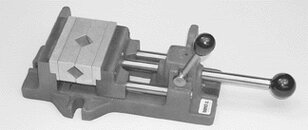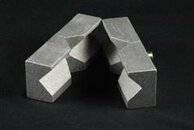A good vise is one of the most valuable tools I can think of for regulator repair, or most other bench tasks for that matter. The Grip Master Vise from Scuba Tools is one of the best I can think of:

Naturally, a vise like this must be bolted to a bench. More important than the rapid acting vise is the set of V-shaped soft jaws that allows a good grip with minimal risk to the chrome plating:

You can get V-shaped soft jaws for conventional vises from a number of machinist supply houses such as Enco or Travers Tool, though not as well suited as the one from Scuba Tools. Line the jaws of a standard vise with a soft material like copper sheet to prevent scaring parts as a minimum. Old rags often tear and the chrome gets scarred anyway.
A primitive and inexpensive solution is to cut “V” grooves into soft wood blocks and clamp them down on a bench with a couple of C-clamps. Even if you were strong enough to hold the first stage in one hand and the wrench in the other, it is a bad practice because tools often slip and ruin soft brass wrench flats and pin spanner holes.

Naturally, a vise like this must be bolted to a bench. More important than the rapid acting vise is the set of V-shaped soft jaws that allows a good grip with minimal risk to the chrome plating:

You can get V-shaped soft jaws for conventional vises from a number of machinist supply houses such as Enco or Travers Tool, though not as well suited as the one from Scuba Tools. Line the jaws of a standard vise with a soft material like copper sheet to prevent scaring parts as a minimum. Old rags often tear and the chrome gets scarred anyway.
A primitive and inexpensive solution is to cut “V” grooves into soft wood blocks and clamp them down on a bench with a couple of C-clamps. Even if you were strong enough to hold the first stage in one hand and the wrench in the other, it is a bad practice because tools often slip and ruin soft brass wrench flats and pin spanner holes.



